You are currently browsing the tag archive for the ‘Number theory’ tag.
I originally planned to continue the last post by discussing the math battle problem in Episode 1, but I think it’s mostly sufficiently explained in the episode already, though there are some logical holes: Sayuri’s first “proof” isn’t really a proof, and not really an argument either. It just sets up part of the geometry, which Nina extends to actually derive something. The whole thing also relies a bit too much on assumed accuracy of measurements, I think, which I don’t really buy, but once you get past the assumption, things are sound. If you’d like more explanation, however, I can write up something on it.
I also refer you to Prettycatchy’s video explanation:
Instead, in this post, I’ll discuss (and solve) the seven problems posed to Kazuki in Episode 2. In context, they’re presented in reverse order of difficulty, from university-level to lower-middle-school-level, and only the last problem is explained. I’ll go through all of them in order.
- Prove that when 0 < x < π/4, the integral of cosine t from 0 to x is greater than twice the integral of sine t from 0 to x.
In mathematical notation, the inequality to be proven is
Each side is a definite integral, which gives you the area of the region underneath the curve given inside the integral (or the negative area when the curve is below the horizontal axis). In this case, we have t as the independent variable of the function inside the integral, instead of x as is usually the case (since x is the independent variable of the entire expression). The left-hand side is the area of the region bounded by the t-axis, the curve
, the vertical line
and the vertical line
. The right-hand side is the same except the curve is
and you multiply the resulting area by 2. So the inequality states that the gray area is strictly larger than twice the orange area, as shown in the two graphs below:
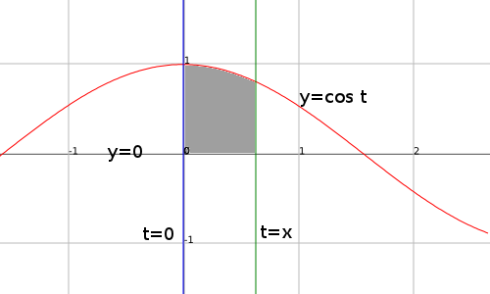

You can evaluate a definite integral by finding the antiderivative and taking the difference of the antiderivative evaluated at the upper point and the antiderivative evaluated at the lower point. The antiderivative of
is
, and the antiderivative of
is
. Doing this and simplifying results in an equivalent inequality:
So if we prove this is true for
, we prove the original inequality.
Let
.
You can plot
over that interval and see that it’s always greater than 1:
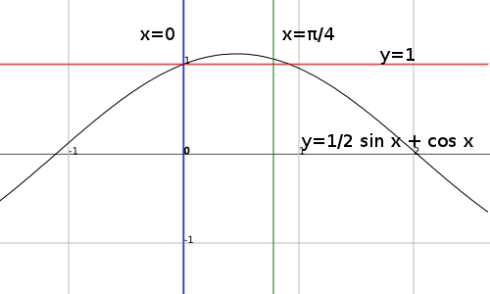
But arguing by graph isn’t a foolproof method (and isn’t feasible to do by hand), so let’s do this analytically. We can do a proof by contradiction: we suppose that there is a point q in
such that the inequality does not hold (that is,
), and show that this leads to a contradiction.
We can now use the mean value and intermediate value theorems to prove that if such a point q exists, then there must be two distinct points in
where the derivative (the slope of the line tangent to the curve at a given point) is 0, which we will show is a contradiction.
We start by checking the coordinates of the endpoints of the interval:
For the first endpoint,
is 1, but since 0 is not itself part of the open interval
, this is not a problem. The right endpoint is greater than one (this can be easily verified by hand by squaring both sides), so it is also consistent with the inequality. Next, we compute the derivative and evaluate it at the endpoints:
So the derivative at 0 is positive, and the derivative at π/4 is negative.
If we connect the left endpoint
and
by a straight line, the slope of the line is
Since
and
, the slope is either zero (if
) or negative. By the mean value theorem, since f is continuous and differentiable (a property of all sinusoids), there must exist a point p in
such that the derivative at p is equal to this slope. So
.
Next, we connect
to the right endpoint
by a straight line. The slope here is
Since
and
, their difference must be positive.
is also positive, so the slope here is positive. Again, by the mean value theorem, this means that there is a point r in
such that
.
We now have constraints on the derivative at the two endpoints as well as some points p and r within the interval.
Since
, this means the value of
goes from positive to zero/negative to positive to negative.
The intermediate value theorem tells us that since
is continuous, for any closed interval
, for every d in
(assuming
; switch the two otherwise), there exists a point c in
where
. This means that any interval
where a is positive and b is zero/negative, or vice versa, must contain a point c where
.
So there must be a point u in
such that
, a point v in
such that
, and a point w in
such that
. Since these are closed intervals with overlapping endpoints, it is possible for u and v to be identical. It is not possible for u and w to be identical, however, since p is strictly less than r.
This shows that there are two distinct points u and w in
whose derivative is 0.
We will now show that this contradicts the properties of the particular f we have. Let us solve for any points c in the interval
with a derivative of 0:
The tangent function is one-to-one in the interval
, so there is at most one c in
such that
. (We can can quickly prove the one-to-one property analytically. First, the tangent function defined for all points in this interval, since the cosine of all points in this range is nonzero. Suppose it’s not one-to-one; then there must be two distinct points m and n in
such that
. This means the slope of the line connecting the two points is 0, so by the mean value theorem, there is a k in
such that the derivative of the tangent function is 0. The derivative is
, which is always positive, so there is no such point.)
Our assumption that there is a point q in
where
leads to the conclusion that there are two distinct points meeting this condition, so there is a contradiction. Therefore, the assumption is not valid, so there is no such q.
So for all points x in
,
. This proves the desired inequality.
- Find the volume V of a regular octahedron with side length a.
A regular octahedron is a polyhedron with 8 faces (each one an equilateral triangle) and 12 sides of equal length. We can compute the volume by splitting the octahedron into two pyramids of equal volume, finding the volume of one of the pyramids, and multiplying by 2.
Let’s look at one of the pyramids. We can compute the volume
, where B is the area of the base, and h is the height. In the figure below, each of the edges is of length a, the height is h, and the diagonal of the square base is d:
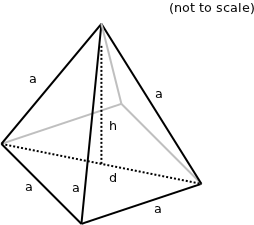
The area of the square base is
. To determine the height h, we can take a cross-section along one of the diagonals. This yields a triangle formed from two of the sides of the octahedron and the diagonal of the square:
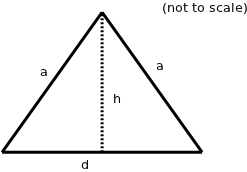
The diagonal has length
. Since two of the sides have the same length, we can divide the isosceles triangle into two right triangles. This yields a triangle with one of the octahedron’s sides as the hypotenuse and two legs: one is half the diagonal of the base square, and the other is the height of the pyramid.
We can use the Pythagorean theorem to relate these:
Multiplying to get the volume of the entire octahedron, we have:
- Find a vector c of length 1 orthogonal to both vector a = (5, 7, 3) and vector b = (7, 6, 5).
One can compute the cross product of two linearly independent vectors to get a vector orthogonal to both.
There are several ways to compute the cross product. One is to make a 3×3 matrix out of the standard basis vectors i, j, and k in the first row and the two vectors in the second and third rows, and then compute the determinant of this matrix. In this case we have
We can break this into three smaller determinants via Laplace expansion:
Then we can easily compute each of the three determinants by multiplying the main diagonal elements and subtracting the product of the other two elements:
So the cross product is
.
But we’re not done yet. The problem wants an orthogonal vector of length one, so we have to normalize the cross product. We can compute the magnitude of the cross product by squaring each component, adding, and taking the square root:
We can divide each of components of the cross product by the magnitude to produce a vector pointing in the same direction with length 1:
There are two possible answers, actually. The vector can point in the same direction as the cross product, as given above, or it can point the opposite way. Either of these is acceptable:
- Find the radius of the inscribed circle in triangle ABC, where AB = 5, BC = 7, and CA = 3.
The circle inscribed in a triangle is the circle that is tangent to all three sides of the triangle:
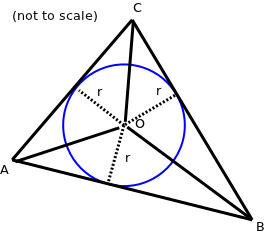
Here we have triangle
with the inscribed circle at center O with radius r. The triangle can be partitioned into three triangles
,
, and
.
The area of each of the triangles is equal to half of the radius r times the length of the edge tangent to the circle.
The area of the entire circle can be found by using Heron’s formula:
where s is the semiperimeter:
For the triangle given in the problem, we have
The total area is equal to the sum of the areas of the three smaller triangles:
Set these equal to each other and solve for r:
- Find the smallest positive integer n such that 765n is a square number.
A square number is an integer whose square root is also an integer. This requires that each prime factor of the number have an even multiplicity, so that you can divide the factors into two identical groups, each of them multiplying to form the square root.
So for 765n to be square, each of the factors in its prime factorization must appear an even number of times. Since we don’t know what n is yet, we can do it just for 765 (factorization in general is a hard problem, but this one can be done by hand easily, once you observe that it’s a multiple of both 3 and 5):
3 already appears twice, but 5 and 17 each appear once. Therefore n needs to have an odd number of occurrences of 5 and 17 for 765n to be square. Since we want the smallest positive integer that works, we can just multiply 5 and 17:
- Solve the system of equations 5x + 7y = 3, 7x – 6y = 5.
Sayumi’s favorite pastime, solving systems of equations!
This can be done using several methods, but some form of Gaussian elimination is probably the most fun.
To do so, we take the system of equations and put the coefficients in an augmented matrix, with the right-hand values in a column on the right:
We divide the first row by the leftmost element, 5, to get a 1 in the upper left:
Then we subtract 7 times the resulting first row from the second row, to put a 0 in the lower left corner:
Now we divide the second row by -79/5 to get a 1 there as well:
Finally we subtract 7/5 times the second row from the first row to get an identity matrix:
This translates back into
, which is our solution.
- The time is 3:00. Between 3:00 and 4:00, what hour, minute, and second will the minute hand and the hour hand overlap exactly?
This was sufficiently explained in the episode, I think, so I won’t discuss it in detail. The idea is to determine the angular velocity of the minute hand and the hour hand (6°/min and 0.5°/min, respectively), find their relative difference (5.5°/min), and divide the initial angular displacement (90°) by this relative velocity to get the time it takes for the hands to overlap, which is 16 and 4/11 minutes. 4/11 of 60 seconds is 21.8181… seconds, or approximately 22 seconds. So the time would be 3:16:22.
Prettycatchy has another video explanation here:
With those 7 problems solved, I look forward to seeing what awaits us in the next episode!! (^_^)
Introduction: Hello! Project’s Central Mystery
For ages, it has defied explanation, piggybacking on one group name after another. It waits, announcing its presence in a subtle yet forceful fashion, catching the eye with its unexpected existence yet never explaining its purpose. This elusive typographical flourish is none other than the ideographic full stop (。) at the end of several Hello! Project group names: モーニング娘。 (Morning Musume。), ココナッツ娘。 (Coconuts Musume。), カントリー娘。 (Country Musume。), アイスクリー娘。 (Ice Creamusume。), ミニモニ。 (Mini Moni。), エコモニ。 (Eco Moni。)—but interestingly, not プッチモニ (Pucchi Moni), a puzzle that we may be able to solve shortly. Unlike the names that precede it, this hardy symbol has proven immune to transformations like romanization: while “モーニング娘” can be written “MORNING MUSUME” in official documents (often, but not always, in all caps), the stop itself is never replaced by its Latin counterpart (.). There is something intrinsic to the ideographic full stop, then, that would be lost in translation. But what is it? As a distinguishing feature of the flagship group’s name since the very beginning, this little circular symbol lies at the heart of the Hello! Project enterprise, and understanding its true meaning may very well be the key to unlocking H!P’s greatest mysteries.
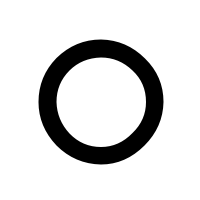
Perhaps it is a simple matter of topology. The ideographic and Latin full stops can be viewed as essentially a zero-dimensional point and a one-dimensional circle, respectively. Since they are represented in two dimensions on the page, however, we can also consider them to be projections of two-dimensional objects in a three-dimensional space (the page itself is a two-dimensional Euclidean plane, so we must go to higher dimensions to have other types of two-dimensional objects). From this perspective, the ideographic full stop is homeomorphic to a 1-torus, while its Latin counterpart is homeomorphic to a sphere. These are distinct homeomorphism classes since there is no continuous deformation from one to the other, just as there is no way to continuously deform a donut into a ball.
But of course this does not explain the relevance of the full stop to Hello! Project. One important characteristic of the full stop is that it appears in the names of groups, so it is inextricably linked to H!P’s concept of a group. We may therefore be able to come to a fuller understanding of H!P by studying the structure of its constituent groups.
The term group also has a mathematical meaning, of course, and while on the surface the two meanings may seem disparate and unrelated, an in-depth analysis from a group-theoretic standpoint does yield a surprising number of coincidences, suggesting that H!P groups do have inherent mathematical structure worth taking a closer look at, whether or not this is the intention of producer Tsunku♂ et al. We may be able to gain insight into the nature of Hello! Project by viewing its groups in mathematical terms, and using group theory as a tool to aid our understanding.
The Basics of Groups
(See also Wikipedia’s article on elementary group theory, which may be a more useful intro to group theory.)
The mathematical discipline of group theory, a part of abstract algebra, examines the algebraic structures called groups. Groups are a central concept in algebra and other areas of mathematics, and have also found applications to physics, chemistry, computer science, and linguistics, among other fields.
Definition: A group consists of a set of objects along with a binary operator that can be applied to any two objects in the set. We can denote the set as G and the operator as ×, which for explanatory purposes we’ll call “multiplication” in a general sense, though numerical multiplication is only one example of a binary operator. Furthermore, the four group axioms must hold:
- Closure: For all a, b in G, a × b is also in G. (The result of multiplying any two elements in the set produces an element in the set.)
- Associativity: For all a, b, c in G, (a × b) × c = a × (b × c). (When there is more than one multiplication, it doesn’t matter which pair gets multiplied first—the result is the same.)
- Identity: There exists an element e in G such that for all a in G, a × e = e × a = a. (There is an element that can be multiplied with any element, in either order, without changing it.)
- Inverse: For each a in G, there exists an element b in G such that a × b = b × a = e. (Every element can be multiplied with some other element, in either order, to produce the identity.)
If a set and a binary operator defined on the set meet these conditions, then they form a group. We can specify further restrictions to define particular types of groups. For example, we can add commutativity to define the notion of an abelian group:
- Commutativity: For all a, b in G, a × b = b × a. (The order in which you multiply elements doesn’t matter.)
One example of a group (which also happens to be abelian) is the set of real numbers, R, under addition. (Note that here the group operator is addition, not multiplication). We can easily verify that the four group axioms, as well as commutativity, hold (this is not a proof, just an example):
- Closure: The sum of two real numbers is a real number.
- Associativity: For any real numbers a, b, c, (a + b) + c = a + (b + c).
- Identity: 0 is the additive identity. You can add it to any real number without changing it.
- Inverse: For any real number a, -a is its inverse. The sum of the two is 0.
- Commutativity: For any real numbers a, b, a + b = b + a.
The set of real numbers under multiplication is not a group, however, since 0 does not have a multiplicative inverse (there’s no real number you can multiply with 0 to make 1, the multiplicative identity). But you can make this a group by excluding 0.
As we will see shortly, H!P groups consist of both abelian and non-abelian groups.
Hello! Project Groups as Mathematical Groups
Set Composition
There are a number of ways in which to regard H!P groups as groups in the group-theoretic sense. A naïve approach would be to define a set consisting of the members of the group and define some appropriate binary operator over the members. Though this makes some intuitive sense and is relatively simple to start out with, we can easily show that it fails to capture the nature of H!P groups.
A counterexample would be Coconuts Musume。 after Ayaka’s graduation on 2008-04-30. According to the official graduation announcement on Hello! Project’s site, Ayaka, the last remaining member of the group, graduated from Hello! Project as well as Coconuts Musume。 (“2008年4月30日(水)をもちまして『ココナッツ娘。』及び『ハロー!プロジェクト』から卒業することになりました。”) This implies that Coconuts Musume。 as a group did not graduate from Hello! Project. After losing its last member, it must remain as a zero-member group.
Unfortunately, there is no such thing as a zero-element group. That would violate the identity property, which states that there exists an identity element. The smallest group is the trivial group, which contains just the identity and nothing else.
And that is the key to understanding how H!P groups work in a group-theoretic sense. All groups must have an identity, and H!P groups are no exception. What Coconuts Musume。 retained after Ayaka’s graduation was its identity: the name “Coconuts Musume。”. The name did not graduate along with Ayaka but remained as the single persisting feature of the group. Here, the term identity is applicable in both its mathematical sense and its sense of being a name or label, an identifier.
So all true H!P groups have an identity, a name that is distinct from the members who constitute the group but is itself an element of the group. Due to the potential for confusion in terminology, I’ll clarify that I’m using member to refer to a human constituent of a group and element to refer to a constituent of the group in the theoretical sense. In this study, I assume that a group’s elements are solely its identity and its members, but that assumption need not hold in possible alternative group-theoretic conceptions of H!P groups, which I will not consider here. Thus the current lineup of Morning Musume。 has ten elements (that is, it’s a group of order 10): nine members and an identity.
One could argue that the identity is just an insignificant auxiliary feature of a group, but I think treating it as an element in its own right does better to characterize H!P’s conception of its groups. The only element of Morning Musume。 that has remained throughout its changing generations is the identity, and it is solely due to the inclusion of the identity that the current lineup can still claim older songs like “LOVE Machine” or “Renai Revolution 21” as its own, even though none of the current members were around at the time of those releases. The Hello! Project web site acknowledges the importance of the group identity: the official profile of the group has a section devoted to each of its ten elements, and each of the ten elements has its name highlighted in blue. The identity has its own section at the top, where it belongs, since it is the longest lasting and arguably most important element of the group.
Interestingly, H!P uses the term unit (ユニット) to refer to its groups. This term appears, for example, in reference to H!P’s special and shuffle units, and Tsunku♂ uses it frequently. In a mathematical sense, unit can refer to some form of the number 1 (for example, the unit circle, the set of points with a distance of 1 from the origin), which is often the identity element in groups (especially when the group operator is regarded as multiplication). In a way, H!P’s use of the term associates a group with its identity.
Group Operator
Having considered the question of set composition, we now turn to what kinds of binary operators exist in H!P groups. This is a crucial aspect of a group, as the group operator determines the structure of a group, and without it, a group is simply a set, an unordered, unstructured collection of distinct elements. It can also be particularly tricky to discern the existence of a group operator, since it is not always clear what the inherent structure of an H!P group is. That said, we can find examples of group operators in some H!P groups.
Let us turn to the tracklist for Morning Musume。’s album Platinum 9 DISC. Several of the songs are credited to a single member (Mitsui, Michishige, Kamei) or to a subset of the members ({Takahashi, Niigaki, Tanaka}, {Kusumi, Junjun, Linlin}). Especially noteworthy is the use of an interpunct (・) to separate the names. The interpunct is commonly used in mathematics to denote multiplication (a · b), alongside other representations such as a × b, a * b, or simply ab. (My physical copy of the album uses a space to separate the names, which is another common way to denote multiplication.) We can assume that this indicates the application of the group operator to the members in question. As the group operator is associative, we need not specify an order in which pairs should be operated on, but since groups are not in general commutative, the order in which the members are listed may be relevant. (In the next section, I argue that Morning Musume。 is an abelian group, in which case the order of the members is actually not relevant.)
Given the prominence of the “Produced by Tsunku♂” credit on the cover of most of Tsunku♂’s productions, it seems sensible to call the group operator the “Tsunku♂ product” (or maybe “Tsunku♂ produce”) for those groups produced by Tsunku♂.
Groups vs. Non-Groups
We have been discussing H!P groups without really defining what counts as an H!P group and what doesn’t. Here is a good place to distinguish between the two. A common taxonomy of H!P divides it into two categories: “groups” and “soloists”. This classification is largely consistent with our group-theoretic formulation of H!P groups, but there are a few exceptions, which I will now examine more closely. In particular, there are acts commonly classified as “soloists” that are actually groups, and there are acts consisting of more than one member that are not actually groups.
One example of the former is Tsukishima Kirari starring Kusumi Koharu (Morning Musume。). Commonly regarded as a soloist, this is actually a two-element group consisting of the identity “Tsukishima Kirari starring Kusumi Koharu (Morning Musume。)” and the single member Kusumi Koharu. The two elements are distinct from each other: Kusumi is also a member of Morning Musume。, but Tsukishima Kirari isn’t.
Most soloists are not groups. The key criterion is whether or not the soloist’s performing identity is distinct from their own. If so, then the soloist and the identity together form a group; if not, then the soloist is not a group.
On the other hand, we have collections of members that do not constitute groups. One example is the aforementioned “Takahashi Ai · Niigaki Risa · Tanaka Reina”, who are credited for two songs on Platinum 9 DISC. In this case, there is no distinct identity associated with this trio. They are simply individual members appearing together, credited as such. If one applies the group operator to the trio, the result is an element of Morning Musume。, but which one it is depends on the definition of the group operator, a topic we will address in the next section.
In practice, there is not always a clear distinction between groups and non-groups in H!P. Some acts, like Abe Natsumi & Yajima Maimi (°C-ute), have names that are composed of individual members’ names, so it may be equally valid to regard them as individual members appearing together, or as a group with a distinct identity that just happens to resemble the individual members’ names. H!P acts vary a bit in this regard, and some composite names seem more like distinct group identities than others.
One important feature of an identity, however, is its immutability. If you change the name of an identity, it becomes a different identity. So this could be used to determine what counts as a distinct identity. In the case of “Takahashi Ai · Niigaki Risa · Tanaka Reina”, different official representations have used interpuncts and spaces to separate the members’ names, so there is no single correct representation of the name, and hence no distinct identity. On the other hand, Shigepink, Kohappink is an actual group, even if it looks as though it could be a composite of smaller groups Shigepink and Kohappink. The half-stop or comma between the names is invariable, as can be seen in the track listing for 7.5 Fuyu Fuyu Morning Musume。 Mini!. While an interpunct separates Yoshizawa, Niigaki, and Kamei in the track credit above, Shigepink, Kohappink’s credit retains a half-stop.
Group Isomorphisms
Once we can characterize the structure of a group, it is useful to relate it to a more abstract notion of a group. We can say that an H!P group is isomorphic to some abstract group—that the two exhibit the same group structure. In particular, this means that there is a one-to-one correspondence between H!P group elements and elements of the abstract group such that the relationships expressed by the group operator are preserved: if Takahashi, Michishige, and Kusumi correspond to the elements a, b, and c, respectively, in another group, and multiplying Takahashi and Michishige produces Kusumi, then applying the group operator to a and b in the other group should yield c.
One can then apply what is already known about such an abstract group to the H!P group in question, and also relate different H!P groups that are isomorphic to the same abstract group (and hence to each other).
Up to this point, we have not yet conclusively defined the group operator for any group, but for groups with three or fewer elements, we do not need any additional information to determine an isomorphism, as long as we know which element is the identity.
Field Guide???
If this were, say, a field guide to H!P groups in their natural habitats (or should I say group guide, since a field is another kind of algebraic structure), each group could have its own entry with relevant info, statistics, and taxonomic classification. In this post, I will attempt to provide a brief entry for several of the groups, and if any of you are interested, you can try adding entries for the other groups.
The first three entries will include one representative group each of orders 1, 2, and 3; the groups have already been mentioned above.
(Note that the concepts of subgroup and center don’t exactly correspond to their conventional H!P meanings. I’ll discuss these in Part 2.)
| Coconuts Musume。 (post-Ayaka era, May 2008 — ???) | |||||
| Order | 1 | ||||
| Identity | ココナッツ娘。 | ||||
| Elements and inverses |
|
||||
| Cayley table |
|
||||
| Nontrivial proper subgroups and cosets |
|
||||
| Minimal generating sets | {} | ||||
| Center | {e} | ||||
| Cycle graph |
 |
||||
| Isomorphic to | Trivial group | ||||
| Finite? | Yes | ||||
| Simple? | No | ||||
| Abelian? | Yes | ||||
| Cyclic? | Yes | ||||
| Perfect? | Yes | ||||
| Nilpotent? | Yes | ||||
| Solvable? | Yes | ||||
| Tsukishima Kirari starring Kusumi Koharu (Morning Musume。) (2006 — 2009) | ||||||||||
| Order | 2 | |||||||||
| Identity | 月島きらり starring 久住小春(モーニング娘。) | |||||||||
| Elements and inverses |
|
|||||||||
| Cayley table |
|
|||||||||
| Nontrivial proper subgroups and cosets |
|
|||||||||
| Minimal generating sets | {K} | |||||||||
| Center | {e,K} | |||||||||
| Cycle graph |
 |
|||||||||
| Isomorphic to | Cyclic group C2 | |||||||||
| Finite? | Yes | |||||||||
| Simple? | Yes | |||||||||
| Abelian? | Yes | |||||||||
| Cyclic? | Yes | |||||||||
| Perfect? | No | |||||||||
| Nilpotent? | Yes | |||||||||
| Solvable? | Yes | |||||||||
| Shigepink, Kohappink (2006 — ???) | |||||||||||||||||
| Order | 3 | ||||||||||||||||
| Identity | 重ピンク、こはっピンク | ||||||||||||||||
| Elements and inverses |
|
||||||||||||||||
| Cayley table |
|
||||||||||||||||
| Nontrivial proper subgroups and cosets |
|
||||||||||||||||
| Minimal generating sets | {M},{K} | ||||||||||||||||
| Center | {e,M,K} | ||||||||||||||||
| Cycle graph |
 |
||||||||||||||||
| Isomorphic to | Cyclic group C3 | ||||||||||||||||
| Finite? | Yes | ||||||||||||||||
| Simple? | Yes | ||||||||||||||||
| Abelian? | Yes | ||||||||||||||||
| Cyclic? | Yes | ||||||||||||||||
| Perfect? | No | ||||||||||||||||
| Nilpotent? | Yes | ||||||||||||||||
| Solvable? | Yes | ||||||||||||||||
The Cyclic Groups of H!P
It is interesting that Morning Musume。 was founded on a notion of “cycling” through members to establish successive generations, by inducting new members and graduating existing members. Both words in the name also reflect a notion of periodic cycles: mornings are part of the daily cycle, and musume (daughters) are part of a cycle of familial generations. The full stop also adds a notion of periodicity—both in its more common North American name, the period, and its circular shape. All of this suggests that a notion of cyclicity is integral to the concept of Morning Musume。 as a group, and perhaps to others as well, particularly those with the full stop in their names.
Indeed, groups in the mathematical sense can also be cyclic. A cyclic group is one whose elements can be generated by a single element of the group: every element can be produced by successively applying the group operator to the generator. In a multiplicative sense, every element is a power of the generator.
We can then conclude that every H!P group with a circular full stop in its name is a cyclic group. If a group has n members, then it is isomorphic to the cyclic group of order n + 1, which is isomorphic to both Zn+1, the group of integers under addition modulo n + 1, and the complex (n + 1)st roots of unity, . For example, here are the 6th complex roots of unity, a cyclic group of order 6:

(It is worth noting that the circle group, being an uncountably infinite group, is not a cyclic group, so the pictorial representation of the full stop may not be accurate if perceived as a circle. However, it is possible to generate a dense cyclic subgroup of the circle group by using any irrational number as a generator, so there is a valid cyclic group interpretation.)
The three groups detailed above are all cyclic groups, but as we go higher in order, it is possible for groups not to be cyclic, so it is useful to be able to recognize cyclic structure where it exists.
The presence of the full stop establishes Morning Musume。 as a cyclic group of order 10. However, from just this information alone, we cannot conclusively determine Morning Musume。’s group structure. We know that it is isomorphic to the cyclic group of order 10, but we don’t know which isomorphism is correct. Depending on our choice of isomorphism, we could identify different subsets of the members as generators. (In the previous three groups, all isomorphisms are equivalent: any permutation of the members yields the same group structure; but in Morning Musume。, different permutations of the members can yield different group structures. There are in fact 90720 possible distinct group structures you can produce depending on which of the possible permutations of the nine members you pick—I leave the proof of this fact as an exercise for the reader.)
We therefore look to the standard order of H!P’s groups. Hello! Project generally orders its groups by seniority, and the standard order features prominently in musical releases, concerts, and public appearances. It is not an arbitrary order but an integral feature of each group. Accordingly, we use the standard order to enumerate the elements of an H!P cyclic group: the kth member in a group with n members is mapped to k in Zn+1 and to in the group of complex (n + 1)st roots of unity.
This yields the following entry for the current lineup of Morning Musume。:
| Morning Musume。 (Takahashi era, June 2007 — present) | ||||||||||||||||||||||||||||||||||||||||||||||||||||||||||||||||||||||||||||||||||||||||||||||||||||||||||||||||||||||||||
| Order | 10 | |||||||||||||||||||||||||||||||||||||||||||||||||||||||||||||||||||||||||||||||||||||||||||||||||||||||||||||||||||||||||
| Identity | モーニング娘。 | |||||||||||||||||||||||||||||||||||||||||||||||||||||||||||||||||||||||||||||||||||||||||||||||||||||||||||||||||||||||||
| Elements and inverses |
|
|||||||||||||||||||||||||||||||||||||||||||||||||||||||||||||||||||||||||||||||||||||||||||||||||||||||||||||||||||||||||
| Cayley table |
|
|||||||||||||||||||||||||||||||||||||||||||||||||||||||||||||||||||||||||||||||||||||||||||||||||||||||||||||||||||||||||
| Nontrivial proper subgroups and cosets |
|
|||||||||||||||||||||||||||||||||||||||||||||||||||||||||||||||||||||||||||||||||||||||||||||||||||||||||||||||||||||||||
| Minimal generating sets | {TA}, {KE}, {MA}, {L} | |||||||||||||||||||||||||||||||||||||||||||||||||||||||||||||||||||||||||||||||||||||||||||||||||||||||||||||||||||||||||
| Center | {e,TA,N,KE,MS,TR,KK,MA,J,L} | |||||||||||||||||||||||||||||||||||||||||||||||||||||||||||||||||||||||||||||||||||||||||||||||||||||||||||||||||||||||||
| Cycle graph |
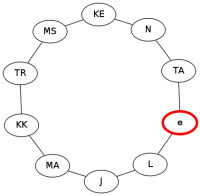 |
|||||||||||||||||||||||||||||||||||||||||||||||||||||||||||||||||||||||||||||||||||||||||||||||||||||||||||||||||||||||||
| Isomorphic to | Cyclic group C10 | |||||||||||||||||||||||||||||||||||||||||||||||||||||||||||||||||||||||||||||||||||||||||||||||||||||||||||||||||||||||||
| Finite? | Yes | |||||||||||||||||||||||||||||||||||||||||||||||||||||||||||||||||||||||||||||||||||||||||||||||||||||||||||||||||||||||||
| Simple? | No | |||||||||||||||||||||||||||||||||||||||||||||||||||||||||||||||||||||||||||||||||||||||||||||||||||||||||||||||||||||||||
| Abelian? | Yes | |||||||||||||||||||||||||||||||||||||||||||||||||||||||||||||||||||||||||||||||||||||||||||||||||||||||||||||||||||||||||
| Cyclic? | Yes | |||||||||||||||||||||||||||||||||||||||||||||||||||||||||||||||||||||||||||||||||||||||||||||||||||||||||||||||||||||||||
| Perfect? | No | |||||||||||||||||||||||||||||||||||||||||||||||||||||||||||||||||||||||||||||||||||||||||||||||||||||||||||||||||||||||||
| Nilpotent? | Yes | |||||||||||||||||||||||||||||||||||||||||||||||||||||||||||||||||||||||||||||||||||||||||||||||||||||||||||||||||||||||||
| Solvable? | Yes | |||||||||||||||||||||||||||||||||||||||||||||||||||||||||||||||||||||||||||||||||||||||||||||||||||||||||||||||||||||||||
With this group structure, we can evaluate the combinations of group members mentioned earlier (and since all cyclic groups are abelian, the order in which we apply the group operator does not matter):
- Takahashi · Niigaki · Tanaka = 1 + 2 + 5 = 8 = Junjun
- Kusumi · Junjun · Linlin = 6 + 8 + 9 = 23 ≡ 3 (mod 10) = Kamei
Or, equivalently, treating the operation as a product (the “Tsunku♂ product”) of complex numbers:
- Takahashi · Niigaki · Tanaka =
= Junjun
- Kusumi · Junjun · Linlin =
= Kamei
Of course, this raises newer questions that we have yet to answer, but it seems Kamei is somehow responsible for “Guruguru JUMP”.
If we consider °C-ute a cyclic group as well, interpreting the degree symbol (°) to be analogous to the full stop, we have the following entry (assuming standard order to resolve among the 120 possible distinct group structures):
| °C-ute (post-Arihara era, July 2009 — present) | |||||||||||||||||||||||||||||||||||||||||||||||||||||||||||||||||
| Order | 7 | ||||||||||||||||||||||||||||||||||||||||||||||||||||||||||||||||
| Identity | °C-ute | ||||||||||||||||||||||||||||||||||||||||||||||||||||||||||||||||
| Elements and inverses |
|
||||||||||||||||||||||||||||||||||||||||||||||||||||||||||||||||
| Cayley table |
|
||||||||||||||||||||||||||||||||||||||||||||||||||||||||||||||||
| Nontrivial proper subgroups and cosets |
|
||||||||||||||||||||||||||||||||||||||||||||||||||||||||||||||||
| Minimal generating sets | {U}, {Y}, {N}, {S}, {O}, {H} | ||||||||||||||||||||||||||||||||||||||||||||||||||||||||||||||||
| Center | {e,U,Y,N,S,O,H} | ||||||||||||||||||||||||||||||||||||||||||||||||||||||||||||||||
| Cycle graph |
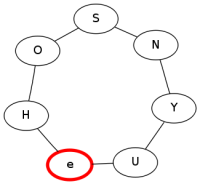 |
||||||||||||||||||||||||||||||||||||||||||||||||||||||||||||||||
| Isomorphic to | Cyclic group C7 | ||||||||||||||||||||||||||||||||||||||||||||||||||||||||||||||||
| Finite? | Yes | ||||||||||||||||||||||||||||||||||||||||||||||||||||||||||||||||
| Simple? | Yes | ||||||||||||||||||||||||||||||||||||||||||||||||||||||||||||||||
| Abelian? | Yes | ||||||||||||||||||||||||||||||||||||||||||||||||||||||||||||||||
| Cyclic? | Yes | ||||||||||||||||||||||||||||||||||||||||||||||||||||||||||||||||
| Perfect? | No | ||||||||||||||||||||||||||||||||||||||||||||||||||||||||||||||||
| Nilpotent? | Yes | ||||||||||||||||||||||||||||||||||||||||||||||||||||||||||||||||
| Solvable? | Yes | ||||||||||||||||||||||||||||||||||||||||||||||||||||||||||||||||
Being a cyclic group of prime order, °C-ute is a simple group, as opposed to Morning Musume。, which is not currently a simple group but has been so several times in the past. Prior to losing Arihara, however, °C-ute was also not a simple group, and in addition, had the curious distinction of being a group whose leader (Yajima) was not a generator, since Yajima’s index, 2, is not relatively prime to °C-ute’s group order at the time, 8. In most groups, the leader has the highest seniority and accordingly has an index of 1, which is relatively prime to everything, so it is usually the case that the leader is also a generator.
With that, we end our discussion of cyclic groups in H!P. Not all groups are cyclic, however, and while one valid approach would be to categorize all H!P groups as cyclic (since there is a cyclic group for every positive integer order), the characteristics of some H!P groups suggest that they exhibit different group structures not isomorphic to cyclic groups. And this is where H!P groups start to get very interesting, but as I’ve already written way too much for this post, I’ll end it here and promise to resume next time with a survey of a variety of non-cyclic Hello! Project groups, as well as a possible explanation for the lack of a full stop in Pucchi Moni’s name and the meaning behind the V in Pucchi Moni V.
to be continued…

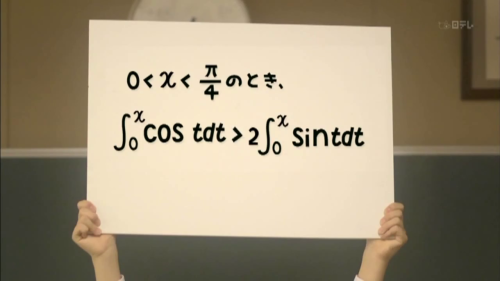


Recent Comments